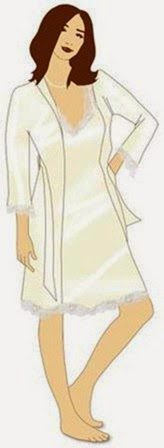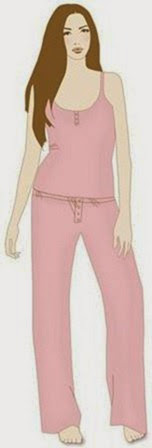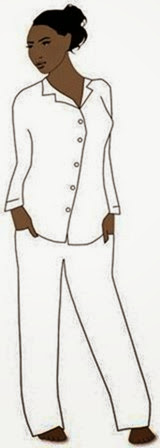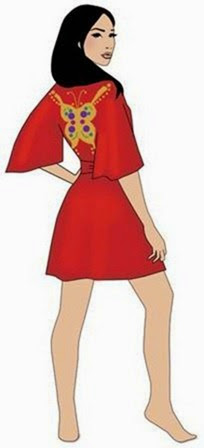Dressing for the Bedroom
In This Chapter
▶ Picking the right pajamas or nightgown
▶ Taking a look at sexy sleepwear choices
▶ Choosing a robe
Whether you’re sleeping alone or with someone special, you always want to look, and more importantly, feel confident and beautiful. So this chapter pertains to everyone — single, married, dating, or divorced, what- ever your status on Facebook says! (For the record, I’m single. Know anyone?) You’re probably rolling your eyes and saying to yourself, “She really wants me to dress up when I go to bed?” No, I don’t want you to dress up like you’re going to a black- tie affair, but I do want you to feel fabulous and comfortable at all times. It all goes back to my 10 System (refer to Chapter 2).
Let me explain: I have a great T-shirt that I got as a freshman at the University of Michigan. It’s 100 percent cotton and, because I’ve worn it over and over again, feels perfect every time I put it on. My goal in this chapter is to help you keep only the sleepwear that is 100 percent something — 100 percent comfortable, 100 percent sexy, or 100 percent special. So ditch those ratty T-shirts that aren’t your favorites and do away with lingerie that no longer makes you feel great. Everything you own, including your PJs, needs to have a reason to be in your closet.
Sleepwear 101
Obviously you should be comfortable when you go to bed, and sleepwear manufacturers (successful ones at least!) are well aware of how important that is. But there are different levels of comfort: cozy-comfortable, cute- comfortable, and sexy-comfortable. You just have to choose one and go with it. Your final outfit of the day should be as put together as you want to feel when you get up the next morning.
Just as you may wear a skirt one day and a pair of pants the next, you can alternate between nightgowns and pajamas and maybe even nothing at all! There’s nothing wrong with switching it up according to your mood or the season, and the best thing about sleepwear is that you get to experiment in the comfort of your own home.
Pajamas
The word pajamas comes from pyjamas, traditional loose pants held up by a string tied around the waist worn in Southeast Asia. The colonial Brits, who paraded around in the blistering sun all dressed up in uniforms or ties and jackets, eventually understood the advantage of the native dress and brought this style back to England toward the end of the 18th century. They added a jacket and found it to be a comfortable sleeping outfit and a nice replacement for drafty nightgowns during their long, cold winters.
Although the basic design of pajamas is pretty set, that doesn’t mean you can’t make a fashion statement in them. Ever since women adopted this particular style, pajamas have come in a greater selection of fabrics, from cotton to flannel to satin and silk. You can even find some made out of eco-friendly bamboo. As to styles, you can choose from a large variety.
In winter, you may want to get as much coverage as possible (and throw on a pair of socks to boot). As the weather heats up, you may prefer shorter sleeves and legs. With all the variety available, your PJ pants can go from full-length to capri-length to shorts, and your tops can shrink from full sleeves to short sleeves to no sleeves.
If PJs are your sleepwear of choice, keep these suggestions in mind:
✓ Stick to natural fibers. Synthetic fibers like nylon or spandex may keep you too warm or may be too constricting.
Although it’s a natural fiber, I don’t recommend wool. Although very warm, it can also be scratchy — not so much fun in bed! If you’re especially cold, better to add another layer of cotton (in the form of thermal underwear, for example) rather than switch to wool PJs.
✓ If you sleep on your stomach, look for PJ tops that pull over your head. Traditional pajama tops generally button down the front, which can be uncomfortable for tummy-sleepers (like me).
If you fall into this category, try a pajama top that pulls over your head, such as one in the T-shirt or cami style (see Figure 13-1).
Figure 13-1: PJs can keep you cute and cozy.
Why not just sleep in any old T-shirt and sweats and avoid the whole button-down-the-front dilemma? Because PJs, which are usually a matching set, help you look pulled together. It all goes back to feeling put together and fabulous, even when you’re just heading off to dreamland.
✓ Limit the number of gimmicky pajamas you have. Pajamas run the gamut from conservative solids (see Figure 13-2) to the most ridiculous prints. Seriously, you can find everything from animal prints to crossword puzzles. These tend to be a very popular gift, especially around the holidays (if your friend likes golf, pajamas with golf balls is a no-brainer). Although it’s okay to have a couple pairs of gimmicky pajamas, you don’t want to look like you belong on the lunch box of a first grader all the time.
✓ Look for pajamas that suit your style. PJs can be sexy or conservative, less material or more, sheer or opaque, camisole or long sleeves. Make sure you select only those that fit you perfectly and are in a style that represents you. Material is also key — choose a fabric that makes you feel comfortable and cozy.
Suffering through a formal affair in high heels is one thing; the last thing you want is to be uncomfortable in bed.
✓ Choose PJs that work best for your body type and accentuate what you want to show off. If you have long legs, for example, try a set with shorts. If you’re on the short side, a design with a vertical stripe elongates your appearance. And if you prefer to keep your partner’s eyes away from your bottom, keep the top button or two of your top undone. (Woo hoo!)
Figure 13-2: A basic pajama set is a perfect look for bedtime.
Nightgowns: Naughty or nice Before there were pajamas, everyone, both male and female, wore night- gowns to bed. The preference for nightgowns had to do with comfort: They didn’t constrict you while you slept, and they allowed couples to be intimate without having to take all their clothes off on a chilly night. Today, night- gowns are still very popular among some women.
If you’re really concerned with camouflaging some body parts, even in the bedroom, a night- gown is your best bet. The flowing style of a nightgown covers up pretty much everything because it doesn’t cling to the tummy or hips or behind. (Nightgowns can be found in plus sizes, so don’t allow anyone to tell you that these outfits aren’t for you if you’re above a certain size.) You can shop for all this sleepwear online, a great solution if you’re too shy or uncomfortable shopping for this kind of clothing in public!
Because nightgown styles vary from conservative (those that totally cover you up) to super sexy (and revealing), you can definitely find a gown that fits your comfort level and sense of style.
✓ The traditional nightgown: Traditionally, nightgowns served two purposes: covering up in the interests of modesty and keeping warm. If that’s what you want in a nightgown, flannel is a good choice. It retains heat, is comfortable, and because it’s opaque, is totally concealing. If, on the other hand, you want your nightgown to silhouette what’s underneath, silk would be your first choice (see Figure 13-3).
✓ Negligees: Negligees are nightgowns designed to be seductive. These usually have more frills (lace and bows, for example) than traditional nightgowns and are made of sheer or semi-transparent material. They also generally reveal more skin. Although you may want to wear a negligee
Figure 13-3: Even though you’re fully covered, a silk nightgown is still sexy.
for your husband’s or boyfriend’s benefit, you need something to cover it up outside the bedroom, especially if other family members are in the house! Luckily, most negligees are sold in sets with a matching peignoir (see Figure 13-4). For all intents and purposes, a peignoir is a robe, only much sexier and fancier.
 Traditionally, a peignoir was the garment a noble woman wore as her personal maid combed her hair (the word peignoir, in fact, is from the French word peigner, which means “to comb hair”).
Traditionally, a peignoir was the garment a noble woman wore as her personal maid combed her hair (the word peignoir, in fact, is from the French word peigner, which means “to comb hair”).
✓ The babydoll: As women became less modest in their outerwear, the trend followed suit in the bedroom, and along came the babydoll. The babydoll is a negligee, except it’s much shorter in length and is generally sold with matching panties (see Figure 13-5). To raise the bar on the sexiness factor, you can wear a babydoll with a thong or a G-string. Figure out which bottom is most flattering for your backside and go for it! Color is another factor in the level of sensuality in a nightgown. A white negligee conveys a mixture of innocence and seduction. A negligee in black or red conveys out-and-out seduction, no matter how many little bows it may have! And if you really want to turn it up a notch, try a negligee in some type of animal print or one that is totally sheer.
Teddies and other things
In the 1920s, the original name for a teddy was camiknickers, because it was a combination of a camisole top and knickers bottoms. It was intended to be worn under shorter skirts. Because the shape reminds one of a teddy bear, the nick- name “teddy” eventually stuck.
Women wearing pants in the factories during World War II adopted the teddies to wear under their work clothes. Although some teddies are still sold because of their utilitarian value as a one- piece undergarment, most are made to be highly suggestive. They don’t leave much to the imagination because they’re see-through and have openings pretty much everywhere. So, ladies, if you’re looking for another option when you want to look seductive in the bedroom, look no further.
It’s a good idea to have some type of sexy sleep- wear in your repertoire. You may not wear it every night, but you want to be able to express your different moods with your clothing. Figure out which style, color, and material best suits you and go for it! You’ll be amazed at how sexy sleepwear makes you feel, not to mention how happy it will make your partner!
I once dated a man who told me that the sexiest thing I ever wore for him was his white button-down shirt. You can make your partner’s clothing work for you, too (see Figure 13-6). Be creative. A woman can be sexy in many different ways; all I needed to do was go shopping in my boyfriend’s closet!
Robes
Figure 13-6: A simple button-down shirt (from his closet) can be as sexy as lingerie.
A robe is generally used to add a layer of warmth to whatever you’re wearing underneath, if anything. Robes designed to keep you warm come in all types of fabrics, and with heating bills going up, there will surely be more and more people putting on their robes right after they lower their thermostats. Today you can buy robes in fleece or microfiber, and they do an excellent job of retaining heat while not being too heavy. The following sections detail the different kinds of robes.
Bath robes
Bath robes are usually made of terry cloth or are at least lined with terry cloth so that when you step out of the shower or bath, you can quickly wrap yourself up against any lurking drafts (see Figure 13-7). You can then step out of the bathroom and head for your bedroom to get dressed knowing that you’re amply covered.
If you prefer robes to sweaters when lounging or working at home, give some thought to how you look. Make sure you choose a robe that flatters your shape. Because robes add an extra thick layer, they can leave you looking very bulky, especially terry cloth robes. As an alternative to terry cloth, try a robe made of silk or cotton. If you have great legs, a shorter robe will flatter you. And keep in mind that darker colors are always more slimming.
Silk robes
A fine silk robe not only gives you a slimmer appearance, but the feel of silk is also very sensuous. Silk also lends itself to many types of imprints (because silk originated in China, many silk robes have an eastern motif). Of course, you can get a solid color silk robe and just bask in the look and feel that simple silk offers. (By the way, woven silk is softer than knit silk, and so better for a robe.)
To reduce the cost of using real silk, some manufacturers offer silk blends or use fabrics that have the appearance of silk but are made entirely of synthetic fibers (nylon or rayon, for example). These synthetic silks don’t have the same luxurious feel of silk, nor do they hold up as well, but they’re still an option.
Figure 13-7: A terry cloth robe.
Kimonos
A kimono is a form of silk robe. Because silk was first woven into cloth in China, the most beautiful silk robes still come from the Far East. Kimonos, which have Chinese or Japanese designs (see Figure 13-8), are elegant and quite beautiful. The more elaborate the design, the higher the price, of course. Traditionally, kimonos were one-size-fits-all garments and were cut on the small side; today, plus-size kimonos are readily avail- able. When selecting a kimono, make sure that the decorative pattern matches your body type. If you have full hips, for example, make sure the design is mostly around your top, drawing the eye away from your hips.
Housecoats
An offshoot of the robe is the housecoat, which is basically a robe meant to be worn during the day, as opposed to the traditional robe which is associated with evening lounge wear. Housecoats are a cross between a dress and a robe. For that reason, the material generally has more of a pattern than does a robe. Although younger women usually put on their jeans or sweats to do household chores, older women sometimes put on a housecoat.
Housecoats are functional and allow for more freedom of movement than jeans do. As long as you don’t decide
Figure 13-8: A silk kimono is both chic and comfortable.
to live in a housecoat 24/7 or let anyone see you in it, they can be an appropriate mode of dress around the house. (They’re definitely not appropriate outside the house, even if you’re just running to the store or the salon.) Really consider how you look and feel before deciding to wear a housecoat. Don’t wear one if it makes you feel dumpy, no matter how practical it may be. Other options are available that will make you feel like a 10.
Vintage sleepwear
Society today is a lot less formal than it used to be; so many people simply sleep in their under- wear, sweats, or nothing at all. (However, I hope this chapter has inspired you to give a little more thought to your nighttime wardrobe than that!) Fifty years ago, however, the nighttime regime included slipping on a complete outfit designed for going to bed. Because the demand for sleep- wear was so much greater back then, people had a lot more to choose from. So if you really want to get fancy, or you’re looking for sleep- wear or loungewear that is special and unique, try shopping for something vintage.
You may not want to wear someone else’s old pair of flannel pajamas, no matter how many times it’s been washed. But when it comes to robes, silk pajamas, and negligee and peignoir sets, you can find fabulous, one-of-a-kind items that will bring the height of glamour to your evenings at home. Even if you don’t want to wear them for sleeping, putting them on to lounge around the house can make those few hours between work and sleep extra special.
These items were usually well cared for, if even worn at all. If you shop carefully, you can find some in impeccable condition that will make you look sensational. A set that is really fancy and in perfect condition can set you back quite a bit (more than you’d normally spend on sleep- wear), but if it’s really special and makes you look and feel great, it can be worth the price. Just remember to take good care of them in order to protect your investment!






